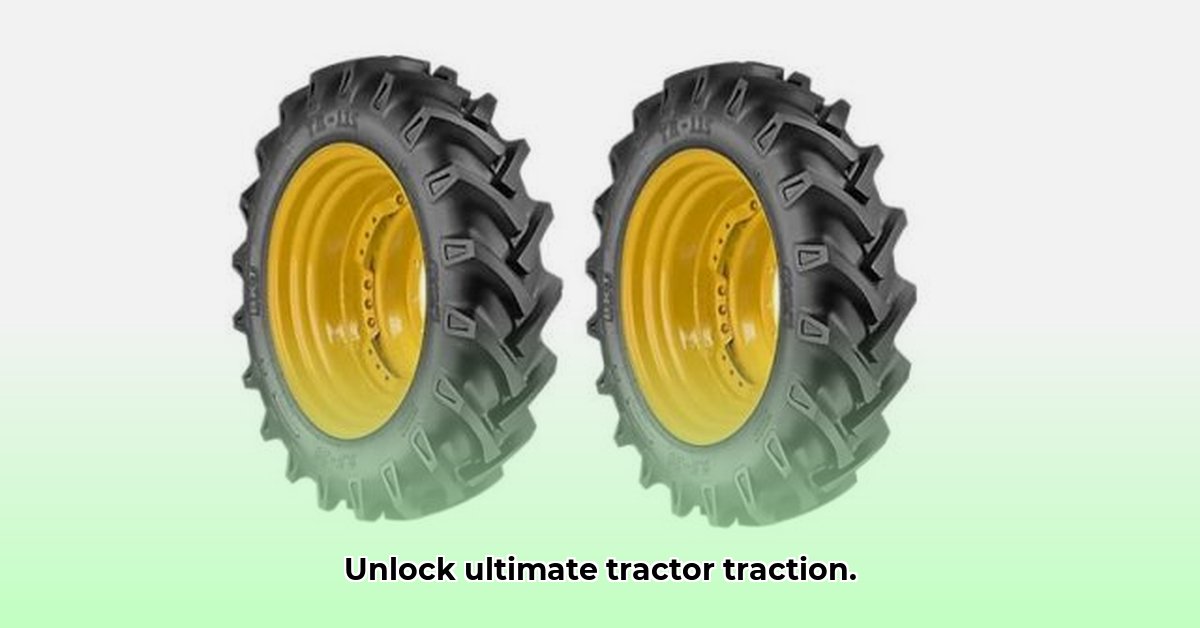
Choosing the right tractor tires is crucial for both operational efficiency and long-term soil health. This guide focuses on R1 tractor tires, outlining their benefits, drawbacks, and strategies for minimizing soil compaction while maximizing traction. We'll compare R1s with R3 and R4 tires to help you make an informed decision for your farm's unique needs. For more on tire additives, check out this interesting article.
Understanding the Trade-off: Traction vs. Soil Health
R1 tractor tires excel in providing powerful traction, particularly in challenging conditions like muddy fields or steep inclines. Their aggressive tread patterns dig into the soil, giving you superior control, especially when pulling heavy loads. However, this excellent grip comes at a cost: increased soil compaction. Compacted soil hinders water infiltration, restricts root growth, and ultimately reduces crop yields. This impacts not only your current harvest but also the long-term health and sustainability of your land. Finding the optimal balance between traction and soil health is key.
A Deep Dive into R1 Tractor Tires
R1 tires' performance stems from several key design features:
- Aggressive Tread Design: Deep, robust treads provide exceptional grip in difficult terrains, minimizing slippage even on steep slopes or in muddy conditions.
- Durable Construction: Built to withstand heavy loads and resist punctures, R1 tires are designed for longevity and reduced downtime.
- Generally Wider Footprint: Compared to other tire types like R3s, a wider footprint (though this varies by model) distributes the tractor's weight over a larger area, potentially reducing compaction in some situations.
It's crucial to remember that even with a wider footprint, using R1 tires for lighter tasks or on less challenging terrains might still lead to unnecessary soil compaction. This highlights the need for careful consideration of your specific farming practices.
Comparing R1, R3, and R4 Tractor Tires
To help you choose the right tire for your operation, let's compare the characteristics of R1, R3, and R4 tires. Remember, individual models within each type can vary, so always refer to the manufacturer's specifications.
| Tire Type | Best Suited For | Advantages | Disadvantages | Soil Compaction Risk |
|---|---|---|---|---|
| R1 | Heavy-duty work, challenging terrain | Excellent traction, durable construction | High soil compaction potential | High |
| R3 | Lawns, delicate surfaces, sensitive crops | Minimal soil compaction, gentle on turf | Reduced traction in challenging conditions | Low |
| R4 | Mixed use, versatile applications | Balance between traction and soil compaction | May not be optimal for extreme conditions | Moderate |
This table provides a general overview. The optimal choice depends heavily on your specific needs and farming practices.
Minimizing Soil Compaction with R1 Tires: Practical Strategies
While R1 tires offer unmatched traction, several strategies can mitigate their compaction impact.
1. Mastering Tire Pressure: Proper inflation is paramount. Under-inflation significantly increases compaction by increasing the tire's contact area with the ground. Over-inflation, however, reduces traction and can damage the tire. Regularly check tire pressure using a reliable gauge, and consider investing in a Central Tire Inflation System (CTIS) for precise, on-the-go adjustments.
2. Strategic Tillage Techniques: No-till or reduced-till farming methods minimize soil disturbance, greatly reducing compaction. These modern farming approaches deserve careful consideration – they show substantial gains in long-term soil health.
3. Tire Rotation: Regularly rotating your tires ensures even wear, extending their lifespan and improving overall performance, leading to more consistent ground pressure and reduced compaction over time.
Making the Informed Choice: A Long-Term Perspective
Selecting the right tractor tires is a long-term investment impacting both your farm's efficiency and the sustainability of your land. Consider these factors:
- Soil Type: Different soil types react differently to compaction.
- Farming Practices: Your tillage methods, crop rotation, and other practices all affect soil health.
- Long-Term Goals: Prioritize sustainable practices for the future prosperity of your farm.
"Choosing the appropriate tire type is a crucial element of a sustainable agricultural practice," says Dr. Emily Carter, Professor of Soil Science at the University of California, Davis. "Understanding the trade-offs and implementing mitigation strategies is essential for responsible farming."
Don't rush the decision. Carefully weigh the advantages and disadvantages of each tire type to choose the best fit for your unique farming operation. A well-informed choice can significantly impact your profitability and environmental responsibility.